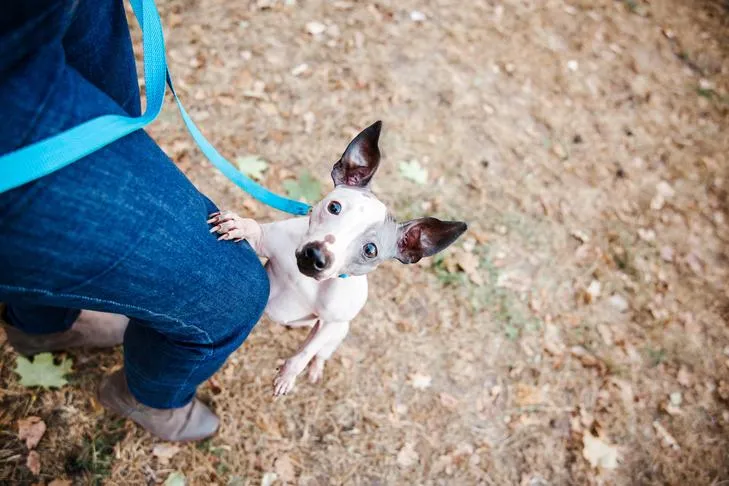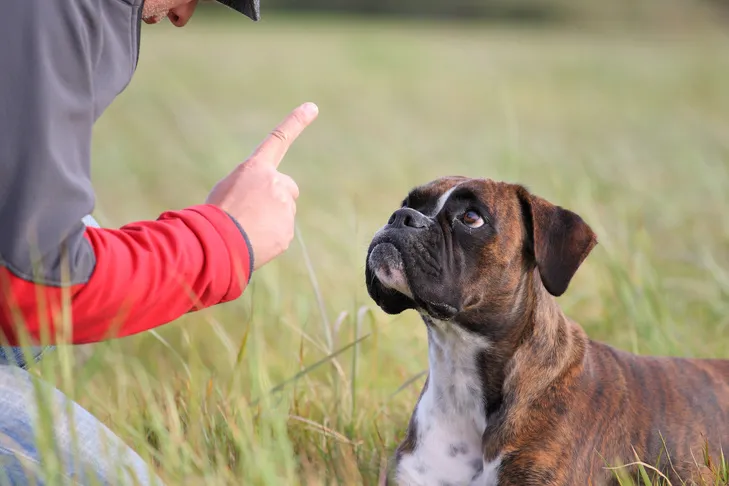Greeting with a jump is a common canine behavior, and while your dog might simply be trying to say “hello” face-to-face, it can be problematic. Large dogs can accidentally knock people over, posing a risk, especially to children and the elderly. Even smaller breeds can leave scratches or muddy paw prints on clothing. For many dogs, jumping is also an effective way to get attention. So, the question is, how do you stop a dog from jumping when it’s such a natural instinct? The key lies in teaching your dog an alternative, more polite greeting rule, such as “keep your front paws on the floor.” This approach is safer, more courteous, and gives your beloved pet an appropriate way to welcome you home and earn your affection. These 10 essential tips will guide you in training your dog to adopt appropriate greeting behaviors, ensuring they know exactly how to say “hi” to humans without jumping.
1. Only Reward Your Dog When All Four Paws are on the Floor
The most effective method for addressing unwanted behaviors is to teach your dog an incompatible alternative. Dogs learn faster and more easily when you show them what to do, rather than just what not to do. In the context of jumping, this means training your dog to keep all four paws on the floor. They cannot jump and stand with all paws down simultaneously. Alternatively, you might prefer them to sit or lie down for greetings. Whatever rule you establish, consistently only greet your dog and give them attention when they are following it. Consistency is crucial; for instance, don’t allow jumping when you’re wearing casual clothes but not when dressed formally. This clear and consistent reinforcement helps your dog understand the desired behavior.
2. Provide Immediate Attention Once Your Dog’s Front Feet Touch the Floor
Dogs tend to repeat behaviors that yield desirable outcomes. Therefore, as long as your dog adheres to your chosen greeting rule—such as keeping their front feet on the floor—provide immediate praise and petting. Your dog craves your attention as a reward, so ensure they receive it without delay when they exhibit the correct behavior, particularly during the learning phase. Avoid delaying your greeting to take off your coat or shoes, as your dog might become impatient and resort to jumping to get noticed. Quick and positive reinforcement reinforces the correct action, making it more likely your dog will repeat it. This is a fundamental step in how to train my dog to stop jumping effectively.
3. Withdraw Attention When Your Dog Jumps Up
Conversely, the only way to eliminate jumping is to stop rewarding it. Never reinforce a behavior you wish to extinguish. If your dog jumps on you, immediately remove what they want: your attention. Try calmly turning your back or walking away, allowing your dog to understand that jumping produces the opposite effect of what they intended. However, as soon as your dog’s four paws are back on the floor, turn back and quietly praise and pet them. This consistent on-off signal of your attention helps your dog connect their behavior directly to your response, teaching them that polite greetings earn interaction, while jumping does not.
 Welsh Springer Spaniel jumping up outdoors, eagerly reaching for attention from a person.
Welsh Springer Spaniel jumping up outdoors, eagerly reaching for attention from a person.
4. Strategically Set Your Dog Up for Success
While ignoring jumping and rewarding appropriate greetings is effective, it can be a trial-and-error process that might be frustrating for your dog. Instead, proactively set your dog up for success by making it easier for them to follow your greeting rule. If your rule is for them to sit, prompt them to sit as soon as you enter the door. If you require four paws on the floor, encourage them to maintain a standing position calmly. A particularly effective method to prevent jumping is to scatter treats on the floor. Most dogs find free goodies irresistible, and they cannot jump while sniffing for treats on the ground. Be quick with the treats; if you offer them before your dog even considers jumping, you can reward the four-on-the-floor behavior with both attention and food. Your dog will quickly learn the new greeting rule, and you can gradually phase out the food rewards. This early intervention is key to how to teach your puppy to stop jumping.
5. Always Reinforce Proper Greeting Behavior
Your dog will master appropriate greeting behavior more quickly if their actions immediately impact your attention. This means that keeping all four feet on the floor gains attention, while jumping makes it disappear. Consequently, you must always reward your dog if they adhere to your greeting rule. Never withhold your attention once your dog’s feet finally touch the floor. Even if you’re feeling irritated after five minutes of persistent jumping, do not let that emotion influence your response. Inconsistency will only confuse your dog and hinder the learning process. Always reinforce the desired behavior to solidify their understanding.
6. Avoid Grabbing or Pushing Your Dog Away
It’s important to remember that your dog is jumping to get your attention. Even a seemingly negative response, such as grabbing your dog, holding their paws, or pushing them away, is still a form of attention. This can inadvertently reward the jumping behavior, potentially increasing its frequency in the long run rather than reducing it. Furthermore, for many dogs, physical interactions like these can be misinterpreted as an invitation to engage in roughhouse play. They might return to jump even harder, believing it’s all part of an exciting game. This counterproductive approach can damage trust and make training more challenging.
 American Hairless Terrier jumping up on the leg of its owner outdoors, showing an owner trying to manage the behavior.
American Hairless Terrier jumping up on the leg of its owner outdoors, showing an owner trying to manage the behavior.
7. Do Not Use Your Knee to Block Jumping
You might have heard the advice to raise your knee to block your dog’s chest when they jump, supposedly to curb the behavior. However, as discussed, this physical interaction can be perceived as attention or a game by some energetic dogs, leading to the opposite of the desired effect. More significantly, for most dogs, this method can erode trust and damage the human-canine bond. Your dog is merely trying to greet you, and responding with a perceived punishment can be distressing and potentially cause injury. A dog that doesn’t trust you may develop other behavioral issues, such as refusing to come when called. Building trust through positive reinforcement is always more effective and humane.
8. Maintain Calm Greetings During the Learning Phase
Because your dog is often overjoyed to see you, controlling their excitement can be challenging. Resisting the natural urge to jump and instead adhering to a new greeting rule requires significant emotional self-control. Make this easier for your dog by keeping your greetings low-key. Dogs are attuned to human emotions; if you are overly excited, they will likely mirror that energy. Instead, maintain a calm and quiet demeanor, even when offering praise. As your dog begins to grasp the new behavior, you can gradually increase your enthusiasm until you can match their excitement without triggering unwanted jumping. This gradual approach is essential for successful training.
9. Prevent Your Dog From Jumping on Guests
You are not the only one who might inadvertently reinforce your dog’s jumping behavior. Other family members, guests, and even strangers on the street can all reward jumping if you are not vigilant. To prevent this, implement management techniques, such as keeping your dog on a leash so they cannot directly approach. An even better strategy is to send your dog to their designated “place”, such as a mat or bed, or place them in their crate so they are not near the door when people arrive. Using a baby gate to block the front hall can also be an effective barrier. These measures help control the environment and prevent opportunities for jumping. Preventing jumping on guests is crucial for how do i stop a dog from jumping on me in varied social situations.
 Boxer laying down outdoors, calmly being trained by a man with treats.
Boxer laying down outdoors, calmly being trained by a man with treats.
10. Instruct Guests and Strangers on Your Greeting Rules
Don’t hesitate to clearly communicate your dog’s greeting rules to guests and even strangers. While your dog is still learning, ask people to completely ignore your dog unless you explicitly say it’s acceptable to interact. Whenever possible, try to avoid encounters with strangers until your dog has fully mastered polite greetings with friends and family members who are consistent in cooperating with your training efforts. In situations where avoiding strangers isn’t possible, use a “watch me” cue or distract your dog with a hand touch or a toy until the person has passed. This proactive communication and management will support your dog’s learning and reinforce the desired polite behavior.
By consistently applying these 10 training tips, you can effectively teach your dog How To Get Your Dog From Jumping during greetings. Patience, consistency, and positive reinforcement are your most powerful tools in guiding your canine companion toward more polite and enjoyable interactions with everyone they meet.
